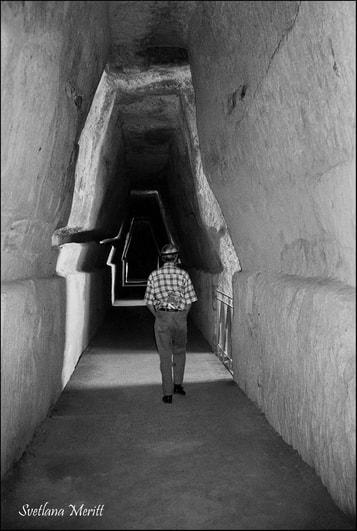 After a year of inactivity, my Photolog of Sacred Sites is back! I’m resuming the presentation of mysterious, intriguing, or famous places of power that have affected people since remote times. In this post I will give an example of a sacred place that has “shut down” due to either desecration of the physical site, debasement of its original purpose, or neglect through loss of human intention—or all three. It’s the famous oracle of Cumaean Sybil in southwest Italy. Cumae was the oldest Greek colony on the Apennine Peninsula, founded in the 9th century BC. It was the Greek Cumeans who introduced the alphabet into Italy and established the oracle where Sibyl divined. Now, Sibyl was actually not a personal name, but a Latinized Greek word for “prophetess”--sibylla. Dedicated to the sun god Apollo, Sibyls were virgin priestesses endowed with powers of divination and believed to be semi-divine beings. As such they were immortal, or nearly so. There were several Sibyls in antiquity, but the Cumean Sibyl was the most famous. She was so venerated that Virgil, in his grand epic the Aeneid, had his hero Aeneas seek guidance from the Cumean Sibyl before undertaking his journey into the Underworld. Her fame stretched well into Renaissance times, when Michelangelo included her in the composition on the ceiling of the Sistine Chapel (although her looks are far from flattering—he painted her to look like a weight-lifter crone). According to the Latin poet Ovid in his Metamorphoses, the Cumean Sibyl lived for about one thousand years. But here’s the clincher: while Apollo granted her the gift of immortality, she forgot to ask for the boon of eternal youth. Ooops … tiny detail. So Sibyl had to live for many hundreds of years as a very old woman, her once-ethereal beauty shriveled into a craggy, haggard face, and her body shrinking with age until, eventually, it was kept in a jar. Finally, only her voice was left. What a fate! Immortality without eternal youth is a rotten deal, if you ask me.
To reach the oracle of the Cumean Sibyl, the visitors of antiquity—as well as of today—had to pass through a long, vaulted tunnel in the shape of trapezoid. This tunnel was built according to the proportions of the golden ratio. The entrance is flanked by two stones that have stood there since antiquity. They are inscribed with verses from Virgil’s Aeneid: one describes the Sibyl’s sanctuary, the other her prophecy to Aeneas. After more than two millennia, the tunnel is still illumined by light shafts, also in the shape of trapezoids. The impression is awe-inspiring; it’s like entering a womb—the dark, mysterious, life-giving womb of an underground goddess. But once inside the sanctuary—a rectangular, soot-colored, vaulted chamber where Sybil prophesied by writing on oak leaves—the impression changes. The cave feels completely “dead,” as if stripped of its energy; like an extinguished fireplace, cold and covered by soot. One possible explanation for the “shutting down” of a sacred site is debasement of its original purpose. In this case, the Cave of Sybil was used as a cemetery after the advent of Christianity. Burying corpses at a place of power alters its energy. But also, for a sacred site to remain active, its energy has to be reinforced through human intention and attention. This is because the Earth energy is volatile and changes its flow. To be harnessed it has to be fixed in place and amplified by human attention or more precisely, the energy that follows attention—prayers, offerings, rituals. We walked out of the cave a bit disappointed, but with an important lesson—sacred sites have their life span too.
0 Comments
Leave a Reply. |
Overview
All
|
